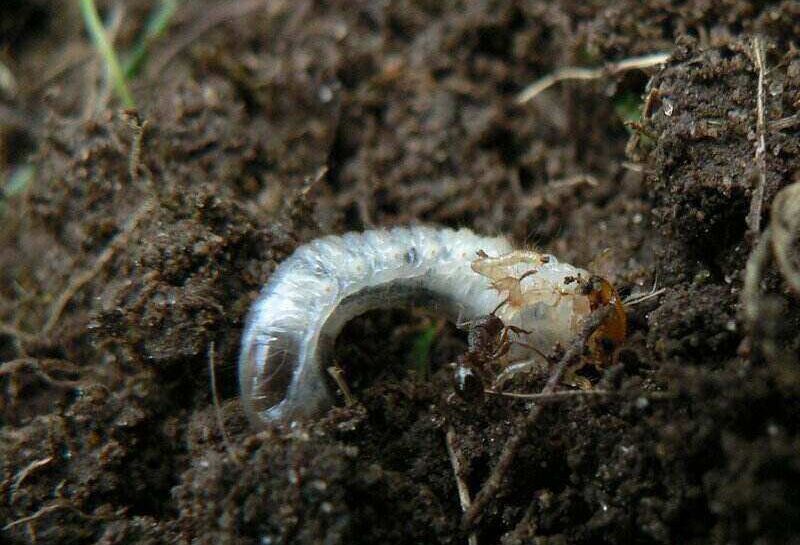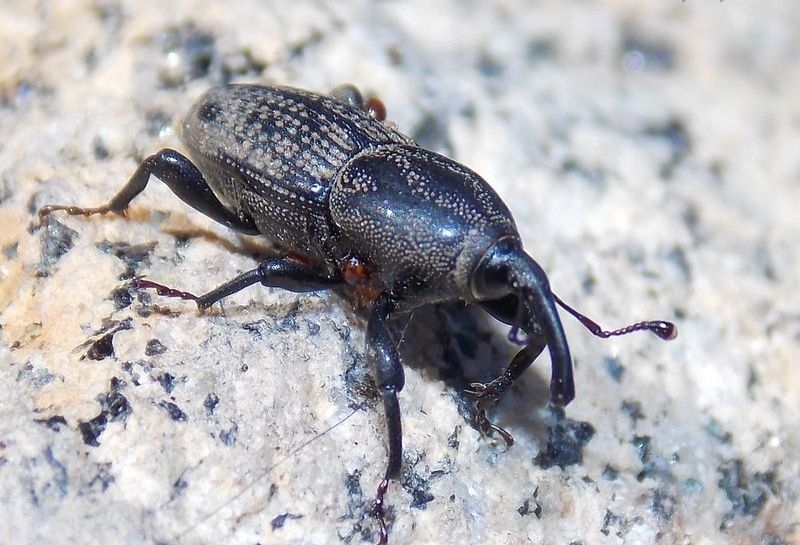
If you have a Zoysiagrass lawn, knowing what common pests might be terrorizing your turfgrass is key to keeping a healthy, attractive yard. These five common pests in Zoysiagrass may be to blame.
In this article, we’ll cover:
- What is Zoysiagrass
- White grubs
- Hunting billbugs
- Chinch bugs
- Sod webworms
- Mole crickets
- Frequently asked questions

What Is Zoysiagrass?
Zoysiagrass is a warm-season grass native to Southeast Asia that has found a home as a lawn grass in the United States. Naturalized from Florida to Southern California and up to Connecticut, its deep root system and stolons make it extremely drought-tolerant, and it can handle shady conditions in warm climates.
There are several varieties of Zoysiagrass, including Zoysia japonica, Zoysia matrella, Meyer Zoysiagrass, and Zoysia tenuifolia. Though all are fairly pest-resistant, some stubborn bugs still love to take up residence in its heavy thatch layer.

White Grubs
White grubs are the worst pests for Zoysiagrass, and they can cause serious damage if there are more than four or five grubs per square foot of grass. These critters are the larvae of several species of scarab beetle, including Japanese beetles, May and June beetles, and green June beetles. All of them feed on plant foliage, making them a nuisance to lawns, crops, and golf courses worldwide.
What white grubs look like: White grubs vary somewhat depending on which beetle species they come from. Generally, however, they are white or cream-colored and around 0.1 to 1 inches with black, brown, or tan heads. The green June grub can be distinguished from other species because it lies stiff and straight rather than in a “C” shape, while Japanese grubs have a distinct “V” arrangement of spines.
Symptoms of white grubs: Spongy soil, grass pulling out from soil easily, yellowing or brown patches of grass
How to treat white grubs: Beneficial nematodes and milky spore are two natural treatment options. In addition, several pesticides are available to eliminate or prevent white grubs. Lawn Love has an excellent, step-by-step guide for getting rid of white grubs.
How to prevent them: Preventative pesticides can be applied if you’ve had problems with white grubs in the past. Regular aeration and proper lawn care will also prevent white grubs.
Hunting Billbugs
Hunting billbugs are another common pest for Zoysiagrass. These members of the weevil family have a distinctive long beak and feed on turf grass as both larvae and adults. Female billbugs even lay their eggs on grass stems.
What hunting billbugs look like: Adult billbugs are reddish-brown or black, and typically ⅓ to ½ inch long, with long beaks and a hardened front set of wings. They have distinctive tan marks on the front of the thorax.
Symptoms of hunting billbugs: Billbug damage appears as browning or yellowing grass in round or irregularly shaped patterns. It’s often confused for fungal diseases or nutrient deficiencies but can be differentiated by hollowed-out stems, or leaves and sheaths that separate easily from the crown of the grass blade.
How to treat hunting billbugs: Many pesticides are available to treat billbugs, though different ones are approved for curative and preventative measures. Some beneficial nematodes are also available. It’s most effective to treat billbugs in the larval or adult stages.
How to prevent them: Preventative insecticides should only be applied in areas where billbug infestations are frequent. Proper lawn care can help your yard to withstand damage.

Chinch Bugs
Chinch bugs are notorious for decimating all kinds of lawns, including Zoysiagrass. These “true bugs” suck up liquid nutrients from grass with their proboscis, leaving behind rapidly spreading dead turf.
What chinch bugs look like: Adult chinch bugs are black and typically around 0.1 of an inch long. They may have long or short wings.
Symptoms of chinch bugs: Areas of brown, yellow, or straw-colored turf that can form a large patch if untreated, usually starting in areas of full sun or near warm pavement.
How to treat chinch bugs: Chinch bugs can be treated with insecticides or natural methods including insecticidal soap, diatomaceous earth, or leaf blower removal (for small infestations). Lawn Love has an excellent guide for eradicating these guys.
How to prevent them: Proper lawn care will help prevent chinch bugs. Avoid over-fertilizing, and dethatch regularly, as lush grass and dense thatch will encourage a greater infestation.

Sod Webworms
The sod webworm family consists of more than 20 lawn moth species. The adult moths don’t damage turf, but larvae feed on grass leaves and stems and burrow into the soil to overwinter or hide during the day.
Sod webworms love a dense thatch layer, and zoysiagrass can accumulate heavy thatch buildup, so these critters can be a major nuisance in Zoysia lawns. More than 15 larvae per foot of turf can create a severe sod webworm infestation.
What sod webworms look like: Adult moths are tan and ½ to ¾ inches long with long snouts and a cigar shape. Larvae are ¾ to 1 inch at mature size and are gray or tan with dark spots and brown heads.
Symptoms of sod webworms: Adult webworm moths are an early symptom of a coming infestation. Look for ragged brown spots in turf that appear scalped, as well as eggs, silk webbing, and green fecal matter.
How to treat sod webworms: Luckily, several effective biological and chemical treatments are available to treat sod webworms, including beneficial nematodes, bacillus thuringiensis, Spinosad bacteria, and several pesticide options.
How to prevent them: Proper lawn care will prevent stress that can worsen an infestation, and regular dethatching and removal of grass clippings will discourage sod webworms. Water your grass appropriately, as sod webworms love dry soils.

Mole Crickets
Mole crickets are notorious pests for many types of turfgrass, and they’re common in Zoysiagrass lawns in the South. Two species, the tawny and Southern mole crickets, are invasive to the U.S. and can damage turfgrass, while the Northern mole cricket is native and less harmful.
The tawny mole cricket is the most dangerous species for lawns, as it feeds almost entirely on grass roots and shoots, and it tunnels in lawn soil.
What mole crickets look like: Tawny mole crickets are tan and around 1 ½ to 2 inches long at mature size, while Southern mole crickets are dark brown and range from 1 to 1 ½ inches.
Symptoms: Piles of dirt left behind from tunnels and mound-building, loosened soil.
How to treat mole crickets: Keep track of where symptoms appear, as mole crickets tend to stay in the same areas of a yard. Targeted pesticide treatments or mole cricket baits in these areas are efficient ways to eliminate mole crickets, and beneficial nematodes are available for homeowners who prefer non-chemical treatments.
How to prevent them: Good lawn care is essential to both preventing mole crickets and helping your lawn manage an infestation. Mow turf at the correct height and fertilize it appropriately to make sure your lawn has all the nutrients it needs. Water well, as mole crickets dig deeper into dry soils.
FAQ about Zoysiagrass pests
No. Although armyworms are a common pest for bluegrass or warm-season grasses like Bermudagrass, St. Augustinegrass and Zoysiagrass are resistant to them.
Yes! Mole crickets are a common pest of Zoysiagrass and are increasingly common in many grasses across the Southeast.
An easy way to determine whether your yellowing or browning grass is due to white grubs or a fungal disease is to try to pull out the damaged turf from the soil. If your grass comes out easily, it’s likely that the roots are damaged from hungry white grubs.
Getting help for pests in Zoysiagrass
Zoysia is one tough turfgrass, but if you’re concerned about pests in your zoysiagrass, don’t let things get out of hand. The quicker you tackle a pest problem, the easier it will be to treat it. Don’t delay – call one of our lawn care professionals today.
Main photo credit: Bill Wilson | Flickr | CC BY 2.0
